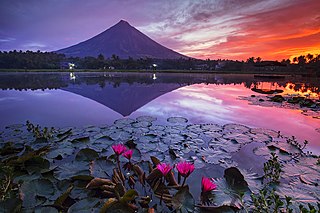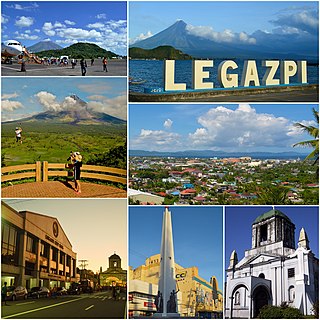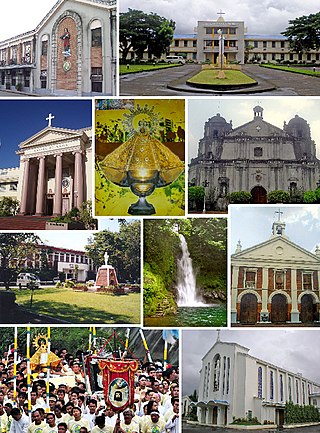Related Research Articles

Albay, officially the Province of Albay, is a province in the Bicol Region of the Philippines, mostly on the southeastern part of the island of Luzon. Its capital is the city of Legazpi, the regional center of the whole Bicol Region, which is located in the southern foothill of Mayon Volcano.

Sorsogon, officially the Province of Sorsogon, is a province in the Philippines located in the Bicol Region. It is the southernmost province in Luzon and is subdivided into fourteen municipalities (towns) and one city. Its capital is Sorsogon City and borders the province of Albay to the north.

The Bicol Region, commonly shortened to Bicol and designated as Region V, is an administrative region of the Philippines. Also referred to as Bicolandia, it comprises six provinces, four on the Bicol Peninsula : Albay, Camarines Norte, Camarines Sur, and Sorsogon, and two off the shore: Catanduanes and Masbate.

Camarines Sur, officially the Province of Camarines Sur, is a province in the Philippines located in the Bicol Region on Luzon. Its capital is Pili and the province borders Camarines Norte and Quezon to the northwest, and Albay to the south. To the east lies the island province of Catanduanes across the Maqueda Channel.

Legazpi, officially the City of Legazpi, is a 1st class component city and capital of the province of Albay, Philippines. According to the 2020 census, it has a population of 209,533. Legazpi is the regional center and largest city of the Bicol Region, in terms of population. It is the region's center of tourism, education, health services, commerce and transportation in the Bicol Region.

Sorsogon City, officially the City of Sorsogon, is a 2nd class component city and capital of the province of Sorsogon, Philippines. According to the 2020 census, it has a population of 182,237 people. Sorsogon City is the third most populous city in the Bicol Region and one of the leading cities in urbanization and most promising city in terms of development.

Guinobatan, officially the Municipality of Guinobatan, is a 1st class municipality in the province of Albay, Philippines. According to the 2020 census, it has a population of 85,786 people.

Santo Domingo, officially the Municipality of Santo Domingo,, is a 4th class municipality in the province of Albay, Philippines. According to the 2020 census, it has a population of 37,765 people.

Magallanes, officially the Municipality of Magallanes, is a 2nd class municipality in the province of Sorsogon, Philippines. According to the 2020 census, it has a population of 37,411 people.

Philippine epic poetry is the body of epic poetry in Philippine literature. Filipino epic poetry is considered to be the highest point of development for Philippine folk literature, encompassing narratives that recount the adventures of tribal heroes. These epics are transmitted through oral tradition using a select group of singers and chanters.

Naga, officially the City of Naga, or the Pilgrim City of Naga, is a 1st class independent component city in the Bicol Region of the Philippines. According to the 2020 census, it has a population of 209,170 people.

Ragay, officially the Municipality of Ragay, is a 1st class municipality in the province of Camarines Sur, Philippines. According to the 2020 census, it has a population of 59,770 people.

The Metropolitan Archdiocese of Cáceres is a Latin Church archdiocese of the Catholic Church in the Philippines. It is a metropolitan see that comprises the Bicol Region, while directly overseeing the third, fourth, and fifth congressional districts of Camarines Sur, Naga City, Iriga City and the Municipality of Gainza. The archdiocese, having been founded in 1595 in Nueva Cáceres, is also considered one of the oldest dioceses in the Philippines with Cebu, Segovia and Manila, and once had jurisdiction that stretched from Samar in the south and Isabela Province in the north. The seat of the archdiocese is currently located in Naga City, also known as the Queen City of Bicol.

The Bicolano people are the fourth-largest Filipino ethnolinguistic group. Their native region is commonly referred to as Bicolandia, which comprises the entirety of the Bicol Peninsula and neighboring minor islands, all in the southeast portion of Luzon. Males from the region are often referred to as Bicolano, while Bicolana may be used to refer to females.

Central Bikol, commonly called Bikol Naga or simply as Bikol, is an Austronesian language spoken by the Bicolanos, primarily in the Bicol Region of southern Luzon, Philippines. It is spoken in the northern and western part of Camarines Sur, second congressional district of Camarines Norte, eastern part of Albay, northeastern part of Sorsogon, San Pascual town in Masbate, and southwestern part of Catanduanes. Central Bikol speakers can be found in all provinces of Bicol and it is a majority language in Camarines Sur. The standard sprachraum form is based on the Canaman dialect.

24 Oras Bikol, formerly Baretang Bikol, is a Philippine television news broadcasting show broadcast by GMA Bicol. Anchored by Elmer Caseles, it premiered on September 17, 2012 replacing Bicolandia Isyu Ngonian. It was simulcasted in TV-7 Naga, TV-12 Legazpi, TV-8 Daet, TV-2 Sorsogon, TV-7 Masbate and TV-13 Catanduanes.

Ibalon, or Ibalong, is the ancient name of the Bicol Region in the Philippines. The center of settlement is believed to be either beside the Bicol River at present-day Libmanan, Camarines Sur or in Magallanes, Sorsogon, Philippines, renowned as one of the first Spanish settlements in the island of Luzon. At some point, the name Ibalong was also used by the Spanish to refer to the entire Bicol Peninsula and, to some extent the entire island of Luzon.
Jose Castaño was a Franciscan friar born in Hiniesta in the Province of Zamora, Spain. He took his vows as a Franciscan priest on May 2, 1874 and was sent to Manila on June 22, 1875.
DWLA-TV is a television station in Legazpi City, Albay, Philippines, airing programming from the GMA network. It is owned and operated by the network's namesake corporate parent alongside GTV outlet DWJB-TV. Both stations share transmitter facilities atop Mt. Bariw, Estanza, Legazpi City.

The Ibálong, also known as Handiong or Handyong, is a 60-stanza fragment of a Bicolano full-length folk epic of the Bicol region of the Philippines, based on the Indian Hindu epics Ramayana and Mahabharata. The epic is said to have been narrated in verse form by a native bard called Kadunung.
References
- ↑ Abella, D. (1954). Bikol Annals: A Collection of Vignettes of Philippine History. Manila.
- ↑ Dery, L. C. (1991). From Ibalon to Sorsogon : A Historical Survey of Sorsogon Province to 1905. Quezon City: New Day Publishers.
- ↑ Espinas, M. (1996). The Ibalong : The Bikol Folk Epic-fragment. Manila: University of Santo Tomas Publishing House.
- ↑ Mallari, F. (1990). Ibalon Under Storm and Siege : Essays on Bicol History: 1565-1860. Cagayan de Oro City.
- ↑ Owen, N. (1999). The Bikol blend : Bikolanos and Their History. Quezon City: New Day Publishers.
- ↑ Prado, M. G. (1981). Ibalon : Ethnohistory of the Bikol Region. Legazpi City: AMS Press.
- ↑ Reyes, J. C. (January–February 1979). The Ibalen Epic - A Window to Bicols Pre-history. Boletin Eclesiastico de Filipinas v. 53 nos. 590-591, pp. 61-92.